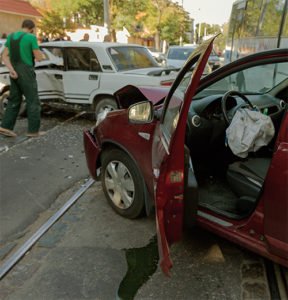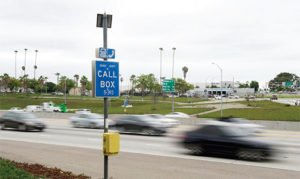 When an accident occurs, congestion quickly builds up and chances of a secondary incident increase. The sooner incidents are detected, the sooner safety personnel can respond to the incident and clear it from the roads thereby allowing traffic lanes to re-open and traffic to return to normal conditions. The system assists with creating a safe work zone with proper signage and equipment for emergency crews responding to an incident.
When an accident occurs, congestion quickly builds up and chances of a secondary incident increase. The sooner incidents are detected, the sooner safety personnel can respond to the incident and clear it from the roads thereby allowing traffic lanes to re-open and traffic to return to normal conditions. The system assists with creating a safe work zone with proper signage and equipment for emergency crews responding to an incident.
In National Highways Public Private Partnership Projects, concessionaires are obligated to establish a system of highway patrol and to make interventions as required for smooth, safe and efficient traffic movement by providing rescue and relief to the users in case of need. In Public funded projects of National Highways Authority of India (NHAI) it deploys at its own cost Highways Control System. In both situations the route patrol is normally the primary source of information about occurrence of such incidents. Secondary sources may be cellphones from drivers or passengers where Traffic Management
centers are set up and such information would be sourced from
CCTV footages and emergency call boxes
The main objectives of incident management are reducing the time for accident detection and verification; reducing response time; exercising proper and safe on-scene management of personnel and equipment, while enabling the traffic to move safely; reducing clearance time to enable normal traffic movement thereafter and providing timely, accurate information to the public that enables them to make informed choices such as alternate routes, etc.
Accident Detection, Verification, Response and Clearance (DVRC) play a major role for a successful Traffic Incident Management Program. ITSdevices such as CCTV cameras cameras, VMS signs, Road Ranger Program, Traffic Management
Centers (TMC) help significantly to accomplish the goals of clearing the accidents faster and taking the victims to the nearby hospital to minimize the severity of the injuries. See Figure 1 for
CCTV monitoring.
Incident response involves response from multiple responders from a variety of organizations each with a specific role and responsibility at an incident scene. For traffic incident management to be effective, it is important that all of these agencies work collaboratively. Following techniques and services are used in Traffic Incident Management:
Photogrammetry
Photogrammetry is a technology that helps traffic police officers to clear the accident scenes faster so that vehicular movement can be restored quickly after reopening the closed roads or closed lanes. The main aim of traffic incident measurement is to reconstruct motor vehicle collision scenes. Whether the final requirements of the process are to assist in calculations, such as vehicle speed; to analyze the dynamics of the collision event; to provide evidence in a subsequent court case; or for some other purpose, the essential first step is to accurately characterize the dimensions of the accident scene.
The most attractive attributes of the photogrammetric approach to accident reconstruction are that the scene can be recorded in a very short time and that the imagery provides a permanent archival record that will support further measurement after the accident. Inexpensive, consumergrade digital cameras are all that are needed. This user-friendly photogrammetric technology – as distinct from the skill intensive processes of traditional stereo photogrammetry – is now employed routinely for accident reconstruction, especially within the highway police patrols of US.
Ambulance Services
Ambulance Services and Trauma Care play very important part in saving lives. There is a need for strengthening of trauma care facilities in the Government hospitals at district level. The Supreme Court has recently decided that every district in the country will have a well-equipped Trauma care center. Once implemented, it will go a long way in treatment and saving lives of a large number of accident victims. In several states, currently 102 and 108 Emergency Medical Services are available, and they are working well. However, these services need to be expanded to cover more areas.
Some private sector organizations particularly in south India are providing very good Ambulance Services. There is need of more such ventures. On the National Highways entrusted to NHAI there is provision of a well-equipped Ambulance at every 50 Km in addition to Highway Patrol Car. The Highway Patrol Car and the Highway Call Box are used for contacting Highway Ambulance.
In the event of hazardous materials involved in such incidents, additional precautions like for wearing of protective clothing by the personnel of the O&M team of the Concessionaire/ Road Agency is necessary. It is a good strategy to keep a list of suitable hospitals on the road corridor available for each stretch.
Traffic Control Measures
It is necessary to ensure that any debris or object on the carriageway as a result of the incident gets cleared up. Use of shoulders, service roads for through traffic could be resorted to for immediate traffic control. Towing of vehicle involved in the incident by crane operator after verification of necessary information details of the vehicle, occupants, registration number are necessary regulations applicable for tow, recovery and crane operator.
Trauma Care
 Injury and trauma, often used interchangeably, represent a major health problem worldwide. Everyday around the world almost 16,000 people die from various injuries. It is startling to note that the lower and middle income group countries (which include India) contribute about 90% of the global burden of injury mortality, thus highlighting the disparities in outcome of trauma between the high, middle, and lower income nations.
Injury and trauma, often used interchangeably, represent a major health problem worldwide. Everyday around the world almost 16,000 people die from various injuries. It is startling to note that the lower and middle income group countries (which include India) contribute about 90% of the global burden of injury mortality, thus highlighting the disparities in outcome of trauma between the high, middle, and lower income nations.
Injuries affect the productive youth of the country. In addition to excess mortality, there is a tremendous burden of disability from extremity, head, and spinal injuries in developing nations. The more tragic fact is that injury is the third most important cause of mortality and the main cause of death among 1 to 40-year-olds. Therefore, trauma effects the productive youth of the country, which is otherwise healthy and free from chronic disease. Road traffic injuries represent only a fraction of the trauma spectrum. In India, most of the available literature regarding trauma epidemiology is pertaining to road traffic injuries and there are hardly any studies done on the other causes of trauma.
The improved survival and functional outcome among injured patients in developed countries can be partly attributed to high-cost equipment and technology. Much of this highend technology is unaffordable and unavailable to victims from developing nations.
The organization of a trauma system has four impact pillars: organization of pre-hospital care facilities, hospital networking, communication systems, and organization of in-hospital care (acute care and definitive care). An integrated approach is required at all levels: human resources (staffing and training), physical resources (infrastructure, equipment, and supplies) and the process (organization and administration). Most of the physical resources for in-hospital care in terms of infrastructure and equipment are already available at secondary and tertiary care hospitals and need moderate upgrades. Therefore, the thrust areas in the field of trauma services are as follows:
- Provide physical resources for pre-hospital care and communication systems.
- Provide well-trained staff at all levels of care from pre-hospital to definitive trauma care. Providers should be well trained and should understand the critical needs of a trauma victim. Skill-based training programs for doctors as well as paramedical staff in Acute Life Support (ALS) procedures are needed.
- Organize and integrate prehospital services with definitive care facilities (hospital) so that a patient is shifted to an appropriate facility in the shortest possible time.
The establishment of the Jai Prakash Narain Apex Trauma Center (JPNATC) at the All India Institute of Medical Sciences in New Delhi is a step forward in providing an apex institution for quality trauma patient care facilities, which will act as a role model for other institutions and centers providing trauma care in the country. More than providing the best patient care facilities, the role of this apex trauma center has been envisaged as an apex research and training institution that will help the nation’s administrators formulate policies regarding the organization of trauma care facilities throughout the country.
The establishment of innumerable trauma centers with heavy financial burden should not be the goal of the policy makers. Instead, upgrading existing hospital infrastructure to treat severely injured patients should be undertaken can be more beneficial.
Atul Kumar, Former Managing Director, Uttrakhand Infrastrasture Development Corporation and Chief General Manager, National Highways Authority of India
 TrafficInfraTech Magazine Linking People Places & Progress
TrafficInfraTech Magazine Linking People Places & Progress


